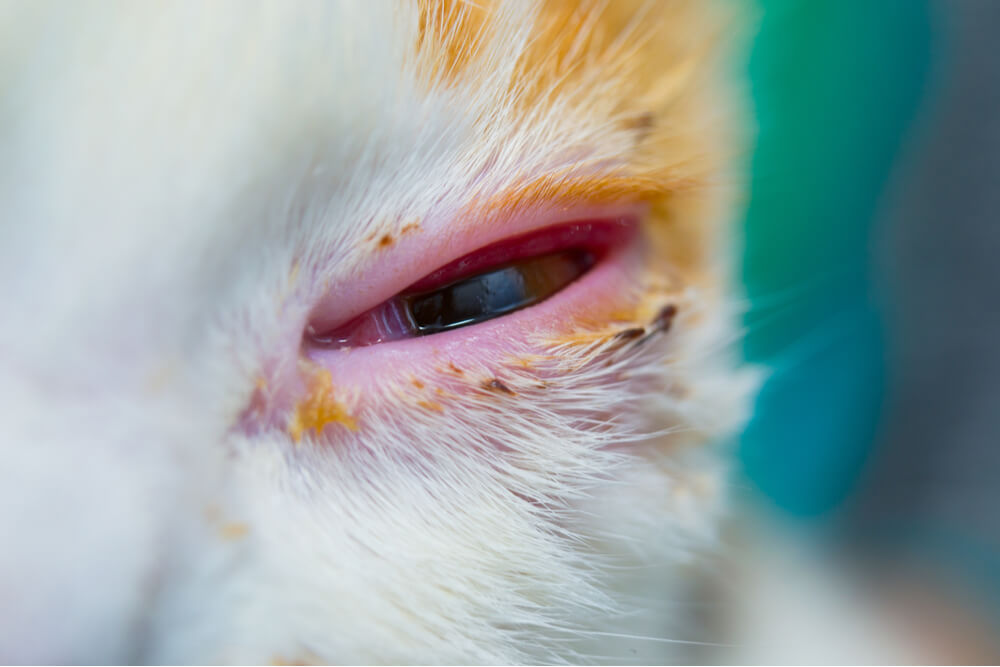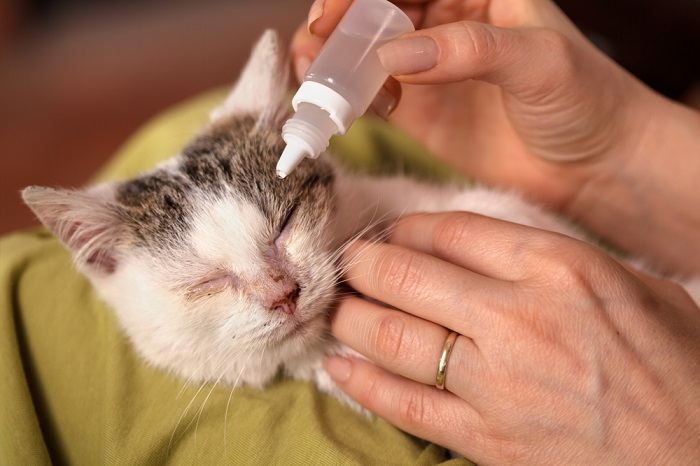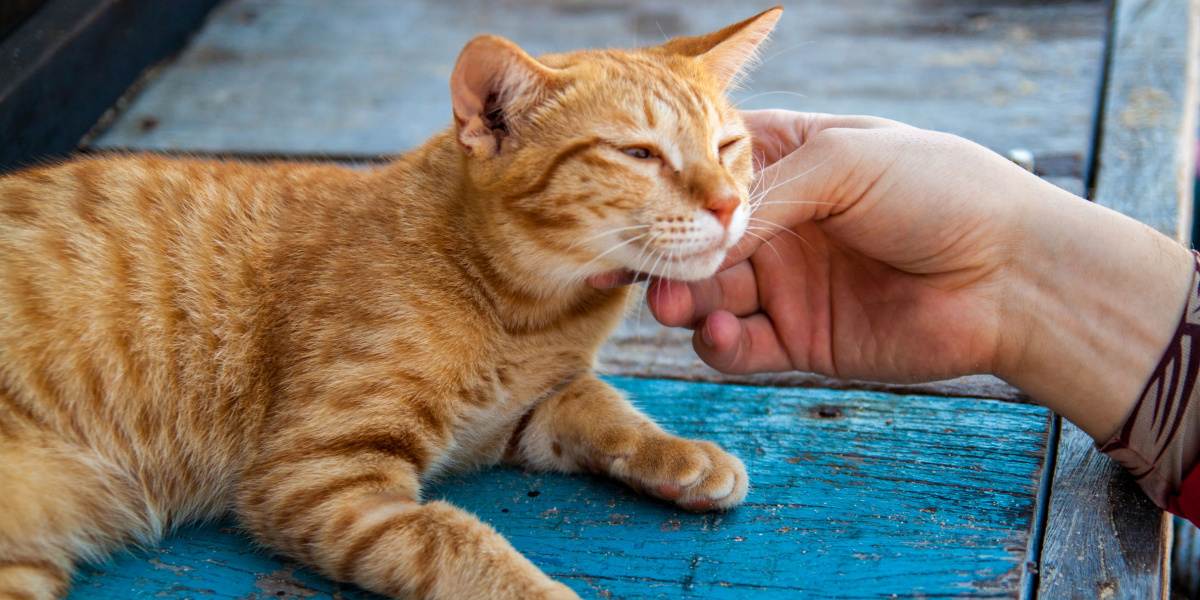
Tobramycin is an antibiotic used most commonly in cats for eye infections. In this article, you will learn more specifically about the tobramycin ophthalmic ointment and solution, potential side effects to watch for, and some of the most frequently asked questions.
Tobramycin for Cats Overview

About Tobramycin for Cats

Tobramycin drops are commonly used for bacterial eye infections.
Tobramycin is an aminoglycoside antibiotic. Aminoglycosides are considered bactericidal and their efficacy is dependent on the concentration of antibiotic present.
Like other aminoglycosides, the spectrum of bacteria that tobramycin is effective against includes: E. coli, Klebsiella, Proteus, Pseudomonas, Salmonella, Enterobacter, Mycoplasma, and Staphylococcus, among others.
Tobramycin does exist in a parenteral or injectable form. However, it is rarely used except in cases where bacterial infections are resistant to more commonly used aminoglycosides, and is only used in a hospital setting.
The more commonly used form of tobramycin as a prescription drug is an ophthalmic preparation, which is used for treating bacterial eye infections on the surface of the eye.
The tobramycin itself kills bacteria by actively being transported inside the bacteria and binding to a special receptor that leads to interference with the bacteria’s protein synthesis. This assists in causing bacterial death.
Also Read: Bacterial Infections In Cats: Causes, Symptoms, & Treatment
What Tobramycin Does

Heavy discharge in the eye can indicate a bacterial infection.
Tobramycin ophthalmic ointment or solution may be commonly used in cats experiencing an upper respiratory infection or conjunctivitis where noticeable swelling of the eye, eyelids, and/or discharge is present.
Like all antibiotics, tobramycin is only effective against bacteria and not as an antiviral or for use against fungal organisms. Because viruses, like feline herpes virus, are common causes of upper respiratory signs and conjunctivitis in cats, it is important for your veterinarian to determine if bacterial involvement is likely.
Heavier mucoid, yellow, or green discharge can be an indication of bacterial involvement. Your veterinarian may wish to collect samples for a cytology to look at under the microscope, or a culture, to determine how to proceed.
Another situation where antibiotic drops like tobramycin are often used is in the case of a scratch or ulcer on the eye. In cats, this is most often due to an injury sustained by another cat. An initial scratch may develop into an ulcer if it gets infected by bacteria.
It is important to make a distinction between typical bacterial ulcers and herpetic ulcers of the eye, which are caused by feline herpesvirus. Viral ulcers cannot be treated with tobramycin and require different treatment. Your veterinarian can help determine the distinction.
Also Read: Cat Eye Infections: Causes, Symptoms, & Treatment
Dosing Tobramycin for Cats

Watch closely for any adverse effects from applying Tobramycin to your cat.
The most common adverse effects of tobramycin include burning and irritation upon application. The conjunctival tissues of the eye and lids may also become red, inflamed, or irritated if a pet is sensitive to tobramycin.
When used systemically in cats, any aminoglycoside, like tobramycin, can cause toxicity to the kidneys and inner ear. Cats can be more susceptible to these effects.
Although ophthalmic tobramycin is not a systemic drug and such effects from an ocular preparation would be rare, it is still recommended to monitor for signs like decreased appetite, lethargy, excessive drinking and urination, vomiting, and balance and coordination issues.
Also Read: 10 Subtle Signs Your Cat May Be Sick
Dosing Tobramycin for Cats

Be gentle when using dropper bottles around your cat’s delicate eyes.
For the tobramycin ophthalmic antibiotic eye drops, common dose recommendations are 1-2 drops in the affected eye. If using an ointment, you generally want a ¼-½ inch strip (about ½ to 1cm) across the surface of the eye.
When applying eye medication, always be careful to apply the drop or ointment without contacting the external eye surface of the cornea with the tube or dropper bottle, as this could further irritate the eye surface.
The frequency is typically at the minimum every 12 hours, but in some cases, your veterinarian may recommend giving the drops four to six times a day or more. Always clarify with your vet how frequently the drops should be given for your cat’s condition.
If your cat is getting any other ocular medications, it is best to use solutions before ointments and to separate medications out by at least 5 minutes.
Eye medications will also be more effective with as little discharge on the surface of the eye as possible. Using a warm damp washcloth, you can provide additional eye care by gently blotting or wiping any discharge from the eyelids. Do not try to wipe the surface of the eye itself, as this can cause keratitis or further irritation of the corneal surface.
Also Read: The 7 Best Cat Wipes For Dander And Dirt
Conclusion

Tobramycin is most commonly used as an ophthalmic drop for infections affecting the eye. Injectable tobramycin is rarely used except in select cases. While most cats will have no problem with tobramycin eye drops, always be aware that cats can have increased sensitivities to this antibiotic class, and monitor your cat for any concerns after starting use.
Also Read: Corneal Ulcers In Cats: Causes, Symptoms & Treatment
Frequently Asked Questions
How Long Does Tobramycin Take to Work in Cats?
The ophthalmic solution of tobramycin, like many eye medications, is rapidly absorbed. It may however, take a couple of days to see visible improvement with an eye infection or injury, owing to the time it takes for bacterial levels to decrease and tissues to heal.
Injectable tobramycin has variable drug absorption depending on the patient. However, if dosed appropriately, susceptible infections should show visible signs of improvement within 2-3 days.
Is Tobramycin a Strong Antibiotic?
Tobramycin does have a broad spectrum of action, like many aminoglycoside antibiotics.
Antibiotics all have different types of bacteria that they can target, and may treat infections in different ways. An antibiotic may be very good at acting against certain strains of bacteria but may be ineffective against others. This does not necessarily make them strong or weak.
For example, tobramycin’s spectrum of activity includes coverage against many oxygen-loving gram-negative staining bacteria as well as some gram-positive staining bacteria. This includes both cocci (round bacteria) and rods (long narrow shaped bacteria). It has almost no efficacy against bacteria that do not utilize oxygen (anaerobic bacteria).
What is Tobramycin Used to Treat?
Tobramycin is an antibiotic used to treat susceptible infections. Its spectrum of action includes infections caused by E. coli, Klebsiella, Proteus, Pseudomonas, Salmonella, Enterobacter, Mycoplasma, and Staph spp. bacterial infections.
Ideally, we always treat with antibiotics based on a bacterial culture and sensitivity panel to know what is growing in an infected area and what antibiotic will be most effective. However, in some cases, a veterinarian may choose an antibiotic based on the likelihood of certain bacteria being present.
Tobramycin is most often used in cats as an ophthalmic preparation to treat infections of the eye. Staph and Mycoplasma are common bacteria that can complicate eye infections (conjunctivitis) in cats.
Cats that develop ulcers on the eye secondary to a trauma from another cat, like a scratch, may also have bacteria like E. coli present, being introduced from the other cat’s nail. These are cases where tobramycin may be the correct choice, but there are other bacteria that are not susceptible to tobramycin, like Chlamydophila felis, another common contributor to conjuntivitis in cats.
Tobramycin has no effect against viruses or fungi. Since many eye problems in cats are caused by viruses, like feline herpesvirus, it is always important to have your veterinarian determine what medication is best.
How Long Should You Use Tobramycin Drops?
For trauma or scratches to the eye that develop into infected corneal ulcers, antibiotic drops like tobramycin are often used for 7-14 days. This may also be the case for simple conjunctivitis.
With any eye condition, especially if a corneal ulcer is present, recheck visits to your veterinarian to stain the eye and re-evaluate the ulcer’s healing, are crucial to successful treatment. In these cases, drops should be continued until after the ulcer is determined to be fully healed based on fluorescein staining.
If you are not sure how long to use tobramycin drops for cats for, always make sure to check with your veterinarian, as the length of time may differ depending on the patient and what is being treated.







